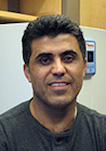Org. Synth. 2016, 93, 75-87
DOI: 10.15227/orgsyn.093.0075
Enantioselective Synthesis of α,α-Disubstituted Lactones via a Chiral Brønsted Acid Catalyzed Intramolecular Cyclization
Submitted by Jennifer E. Wilent, Ghassan Qabaja, and Kimberly S. Petersen
1*
Checked by Bo Qu and Chris H. Senanayake
1. Procedure
A.
Di-tert-butyl-2-methylmalonate (2). An oven-dried 500-mL three-necked round-bottomed flask equipped with an egg-shaped stirring bar (30 mm x 15 mm) is fitted with two rubber septa and placed under an Ar atmosphere through a gas inlet. After cooling to 23 °C,
methyl malonic acid (
1) (12.0 g, 97.6 mmol, 1.0 equiv) (
Note 1) is added followed by addition of
diethyl ether (50 mL) (
Note 2),
4-(dimethylamino)pyridine (1.2 g, 9.8 mmol, 0.1 equiv) (
Note 3),
tert-butyl alcohol (150 mL) (
Note 4), and solid
di-tert-butyl dicarbonate (48.3 g, 214.6 mmol, 2.2 equiv) (
Note 5). The heterogeneous slurry is stirred (500 rpm) at room temperature (23 °C) for 48 h, after which time the reaction mixture became a clear pale yellow mixture (Figure 1). The reaction mixture is then diluted by addition of
diethyl ether (150 mL), transferred to a 1000-mL separatory funnel and washed with
water (2 x 50 mL) and
HCl (1.0 M, 2 x 50 mL). The organic layer is dried over
MgSO4, gravity filtered using coarse filter paper, rinsed with
diethyl ether (2 x 20 mL), and concentrated
in vacuo using a rotary evaporator (27 °C, 7.5 mmHg) to give an oil, which is dissolved in 200 mL of hexanes and
ethyl acetate (10:1) and passed through a plug of silica gel (3 x 5.2 cm) (
Note 6) using a 60-mL medium fritted filter funnel.
Figure 1. Reaction Mixture in Step A after 48 h
The colorless filtrate is received into a 500-mL round-bottomed flask and concentrated
in vacuo using a rotary evaporator (27 °C, 7.5 mmHg), the colorless oil is put under high vacuum (23 °C, 0.4 mmHg) for 30 min to yield 21.1 g of the product
2 as a colorless oil at >99% purity (94% yield) (Notes
7 and
8).
B.
Di-tert-butyl-2-(2-hydroxyethyl)-2-methylmalonate (3a). An oven-dried 500-mL three-necked round-bottomed flask equipped with an egg-shaped stirring bar (30 mm x 15 mm) is fitted with two rubber septa and placed under an Ar atmosphere through a gas inlet. After cooling to 23 °C,
tetrahydrofuran (100 mL) (
Note 9) is added via a syringe and the reaction flask is cooled with an ice-water bath. After stirring for 15 min, NaH (3.13 g, 78.2 mmol, 1.2 equiv) (
Note 10) is added in one portion and the slurry is stirred for an additional 15 min.
Di-tert-butyl-2-methylmalonate (
2) (15.0 g, 65.1 mmol, 1.0 equiv) is dissolved in
tetrahydrofuran (30 mL) in a 100-mL oven dried pear-shaped flask and this solution is transferred by cannula into the
sodium hydride slurry in portions over 15 min. After 30 min
2-bromoethyl acetate (8.9 mL, 78.2 mmol, 1.2 equiv) (
Note 11) is added drop wise via a syringe over a period of 5 min. The reaction mixture is allowed to slowly warm to room temperature (23 °C). The progress of the reaction is monitored by TLC analysis (
Note 12). TLC analysis indicated consumption of the
di-tert-butyl-2-methylmalonate (
2) after 16 h. The reaction flask is cooled in an ice-water bath for 15 min, and a solution of saturated
NH4Cl solution (10 mL) is added drop wise via syringe. The mixture is diluted with
diethyl ether (300 mL) and transferred to a 1000-mL separatory funnel. The ether layer is washed with
water (2 x 50 mL) and saturated
NaCl solution (50 mL), dried over
MgSO4, gravity filtered using coarse filter paper, rinsed with
diethyl ether (2 x 20 mL), and concentrated
in vacuo using a rotary evaporator (27 °C, 7.5 mmHg) to give a pale yellow oil which is dissolved in
methanol (50 mL) (
Note 13). The solution is transferred to an oven dried 500-mL three-necked round-bottomed flask equipped with an egg-shaped stir bar (30 mm x 15 mm) and two septa. A temperature probe is placed through the septum in the side neck to monitor the internal temperature of the reaction (Figure 2). The reaction flask is filled with argon and held under an atmosphere of Ar. The reaction flask is cooled to -20 to -10 °C using
acetonitrile/dry ice bath (
Note 14) and
K2CO3 (9.0 g, 65.1 mmol) (
Note 15) is added in five portions such that the internal temperature stays below -5 °C. After 2 h, the reaction mixture is diluted with
diethyl ether (200 mL) and deionized
water (50 mL) is added drop wise such that the internal temperature stays below -5 °C. The contents of the flask are transferred to a 1000-mL separatory funnel and hexanes (100 mL) are added. The organic layer is washed with
water (3 x 50 mL) and saturated
NaCl solution (50 mL), dried over
MgSO4, gravity filtered using coarse filter paper, rinsed with
diethyl ether (2 x 20 mL), and concentrated
in vacuo using a rotary evaporator (27 °C, 7.5 mmHg) to give a light yellow oil.
Figure 2. Step B Assembly with Temperature Probe Inserted
The oil is dissolved into hexanes (100 mL) and the flask is cooled with an ice-water bath for 1 h to yield a layer of white solids. The solids are broken via a spatula and collected via vacuum filtration into a 100 mL ceramic Buchner funnel equipped with filter paper of moderate porosity and washed with ice-cold hexanes (25 mL). A second crop of solids are obtained after the filtrate is concentrated under vacuum and the residue is dissolved in hexanes (20 mL), cooled with an ice water bath for 2 h and filtered as before. The two batches are combined to yield 10.9 g of product
3a as a white crystalline solid (61% yield) (Notes
16 and
17).
C. (S)-tert-Butyl-3-methyl-2-oxotetrahydrofuran-3-carboxylate (5a). A 500-mL two-necked, round-bottomed flask equipped with an egg-shaped magnetic stir bar (38 x 16 mm) is flame-dried under vacuum. After cooling to 23 °C, di-tert-butyl 2-(2-hydroxyethyl)-2-methylmalonate (3a) (8.5 g, 31 mmol) is added to the round-bottomed flask, a rubber septum is fitted, the reaction flask is put under an atmosphere of Ar, and toluene (310 mL) (Note 18) is added via syringe. A thermometer probe is placed through the septum in the side neck to monitor internal temperature of the reaction. To this clear colorless solution, (R)-3, 3'-bis(2,4,6-triisopropylphenyl)-1,1'-binapthyl-2,2'-diylhydrogenphosphate (4, TRIP) (0.23 g, 0.31 mmol, 0.01 equiv) (Note 19) is added as a solid and an oven-dried reflux condenser is attached. Using an oil bath, the reaction mixture is heated to 80 °C (internal reaction temperature 76-80 °C) with stirring. The reaction is stirred at 500 rpm. The progress of the reaction is monitored by TLC analysis (Note 20). TLC analysis indicated consumption of the di-tert-butyl 2-(2-hydroxyethyl)-2-methylmalonate after 48 h. The round-bottomed flask is allowed to cool slowly in the oil bath to 23 °C. The reflux condenser is removed and EtOAc (50 mL) is added. After stirring for 5 min, the reaction mixture is transferred to a 500-mL separatory funnel and washed with deionized water (250 mL). After the layers separate, the lower, clear water layer is drained and the upper, cloudy EtOAc layer is collected in a 500 mL Erlenmeyer flask. The water layer is returned to the separatory funnel and reextracted with EtOAc (200 mL). The combined EtOAc layers are dried over MgSO4, gravity filtered through coarse filter paper into a 1000 mL round bottomed flask and the MgSO4 is rinsed with EtOAc (50 mL). The 1000 mL flask is concentrated in vacuo using a rotary evaporator (28 °C, 7.5 mmHg) and the crude reaction mixture is purified via flash chromatography (Note 21) resulting in the isolation of 6.02 g (97% yield) of product 5a as a white crystalline solid (98% ee) (Notes 22, 23, and 24).
2. Notes
1.
Methyl malonic acid (96%) was purchased from Acros and used as received.
2.
Diethyl ether was purchased from Pharmaco-AAper (Reagent Grade ACS Anhydrous) and used without purification.
3.
DMAP (
4-(Dimethylamino)pyridine, ReagentPlus®, ≥99%) was purchased from Aldrich and used as received.
4.
tert-Butyl alcohol (99.5%, extra pure) was purchased from Acros and used as received.
5.
Di-tert-butyl dicarbonate (97%) was purchased from Acros and used as received.
6. Silica gel was purchased from Silicylce, Inc. (SiliaFlash P60 (230-400 mesh)) and used as received.
7. Physical characteristics of
di-tert-butyl-2-methylmalonate (
2): colorless liquid with >99% purity as determined by quantitative
1H NMR using dimethyl fumarate as the internal standard;
1H NMR
pdf(500 MHz, CDCl
3) δ: 1.32 (d,
J = 7.4 Hz, 3H), 1.46 (s, 18H), 3.24 (q,
J = 7.5 Hz, 1H);
13C NMR
pdf(126 MHz, CDCl
3) δ: 13.4, 27.9, 48.1, 81.1, 169.6; IR (neat) cm
-1 2978, 1725, 1136, 848; HRMS (C
12H
22O
4, ESI): calculated 253.1415 [M+Na]
+1, found 253.1423;
8. A second run produced 21.3 g of the product
2 as colorless oil, 95% yield, >99% purity.
9.
THF (
tetrahydrofuran, minimum 99%, inhibited with <0.025% butlylated hydroxytoluene) was purchased from Acros and distilled under Ar over benzophenone and sodium.
10.
Sodium hydride (60% dispersion in mineral oil in soluble bags, in resealable cans) was purchased from Acros and used as received.
11.
2-Bromoethyl acetate (97%) was purchased from Acros and used without further purification.
12. TLC analysis was performed on silica gel with 10:1 hexanes-EtOAc as eluent and visualization with
p-anisaldehyde. The starting material has R
f = 0.38 (blue) and the product has R
f = 0.22 (blue). TLC plates were purchased from Silicycle, Inc. (Glass Backed TLC Extra Hard Layer, 60Å).
13. Anhydrous
methanol (anhydrous, 99.8%, AcroSeal (TM)) was purchased from Acros and used received.
14. Saturated
NaCl solution/ice bath was used by the submitting authors. The checkers observed that temperature is difficult to be kept under -5 °C using this cooling bath at this scale after addition of base
K2CO3.
15. Anhydrous potassium carbonate (Certified ACS Granular Powder) was purchased from Fisher and used as received.
16. NMR spectra and purity of the first batch and second batch of
di-tert-butyl 2-(2-hydroxyethyl)-2-methylmalonate (
3a) are the same: white crystalline solid with 98% purity as determined by quantitative
1H NMR using dimethyl fumarate as an internal standard; mp = 38-39 °C;
1H NMR
pdf(500 MHz CDCl
3) δ: 1.40 (s, 3H), 1.48 (s, 18H), 2.09 (t,
J = 6.3 Hz, 2H), 2.13 (br s, 1H), 3.75 (t,
J = 6.3 Hz, 2H);
13C NMR
pdf(126 MHz, CDCl
3) δ: 20.2, 27.8, 38.2, 53.7, 59.0, 81.5, 172.0; IR (neat) cm
-1 3446, 2977, 1710, 1367, 1154, 1112, 1019, 844 ; HRMS (C
14H
26O
5, ESI): calculated 297.1672 [M+Na]
+1, found 297.1665;
17. A second run produced 12.4 g of product
3a, 69% yield, 98% purity.
18. Toluene was purchased from Innovative Technology and passed through a Pure Solv MD 5 Solvent Purification System. The checkers used toluene purchased from Aldrich and distilled over CaH
2.
19.
(R)-3,3'-Bis(2,4,6-triisopropylphenyl)-1,1'-binapthyl-2,2'-diyl hydrogen phosphate (
4) was purchased from Corvinus Chemicals (currently Ark Chemicals) and used as received.
20. TLC analysis was performed on silica gel with 30% EtOAc-hexanes as eluent and visualization with
p-anisaldehyde. The starting material has R
f = 0.37 (blue) and the product has R
f = 0.58 (blue). TLC plates were purchased from Silicycle, Inc. (Glass Backed TLC Extra Hard Layer, 60Å).
21. Column diameter: 3.8 cm, silica: 84.0 g (Silicycle Inc., silica 60 (230-400 mesh), eluant: 500 mL 4:1 EtOAc:hexane), fraction size: 20 mL (16 x 150 mm test tubes), product typically found in factions 6-20.
22. Physical characteristics of
(S)-tert-butyl 3-methyl-2-oxotetrahydrofuran-3-carboxylate (
5a): white solid with 99% purity, as determined by quantitative
1H NMR using dimethyl fumarate as an internal standard; mp = 49-50 °C; [α]
D24.5 = +7.08° (c = 1.08, CHCl
3);
1H NMR
pdf(400 MHz, CDCl
3) δ: 1.49 (s, 12 H), 2.18 (m, 1H), 2.71 (m, 1H), 4.35 (m, 2H);
13C NMR
pdf(100 MHz, CDCl
3) : 20.1, 27.8, 35.1, 50.5, 65.8, 82.8, 169.4, 176.3; IR (neat) cm
-1 2980, 1763, 1730, 1426, 1370, 1227, 1132, 1025, 845; HRMS (C
10H
20NO
4, ESI): calculated 218.13868 [M+NH
4]
+1, found 218.1385;
23. Enantiomeric purity was assessed at 98% ee by chiral HPLC: Chiralcel OJ-3, 4.6 x 150 mm, 3 micro; isocratic: 1% of IPA in heptane; eluent Rate: 1.3 mL/ min; Temperature 5 °C; UV detector 220 nm; RT
major = 10.2 min, RT
minor = 11.2 min.
24. A second run produced 5.97 g of product
5a, 96% yield, 99% purity, 98% ee.
Working with Hazardous Chemicals
The procedures in
Organic Syntheses are intended for use only by persons with proper training in experimental organic chemistry. All hazardous materials should be handled using the standard procedures for work with chemicals described in references such as "Prudent Practices in the Laboratory" (The National Academies Press, Washington, D.C., 2011; the full text can be accessed free of charge at
http://www.nap.edu/catalog.php?record_id=12654). All chemical waste should be disposed of in accordance with local regulations. For general guidelines for the management of chemical waste, see Chapter 8 of Prudent Practices.
In some articles in Organic Syntheses, chemical-specific hazards are highlighted in red "Caution Notes" within a procedure. It is important to recognize that the absence of a caution note does not imply that no significant hazards are associated with the chemicals involved in that procedure. Prior to performing a reaction, a thorough risk assessment should be carried out that includes a review of the potential hazards associated with each chemical and experimental operation on the scale that is planned for the procedure. Guidelines for carrying out a risk assessment and for analyzing the hazards associated with chemicals can be found in Chapter 4 of Prudent Practices.
The procedures described in Organic Syntheses are provided as published and are conducted at one's own risk. Organic Syntheses, Inc., its Editors, and its Board of Directors do not warrant or guarantee the safety of individuals using these procedures and hereby disclaim any liability for any injuries or damages claimed to have resulted from or related in any way to the procedures herein.
3. Discussion
The development of single-enantiomer chiral compounds has been a trend in the drug industry due to the potentially diverse pharmacology and toxicology of different stereoisomers of a molecule. The field of asymmetric methodology development has thus gained importance over the past several decades.
2 Often the key to an enantioselective synthesis is the availability of small chiral building blocks. Enantioenriched α-substituted lactones are common structural motifs and/or key intermediates in the synthesis of many biologically active compounds.
3 Organocatalysis and specifically chiral Brønsted acid and hydrogen bonding catalysts as a strategy to generate single enantiomer compounds through asymmetric synthesis has become a widely explored field.
4Recently, we have developed an enantioselective desymmetrization of prochiral diesters through a Brønsted acid catalyzed intramolecular cyclization to yield lactones containing an α-quaternary center.
5 Disubstituted hydroxy
tert-butyl malonates
3a-3g were readily prepared in 3 steps and in the presence of Binol based chiral Brønsted acid, (
R)- or (
S)
-TRIP (
4), enantioenriched lactones
5a-5g were formed (Table 1). Coordination of the chiral phosphoric acid through one or more hydrogen bonds to the substrate likely leads to a rigid transition state which allows for discrimination of the enantiotopic ester groups.
A bulky ester is necessary for the process, however the R group can vary in length and branching. Small alkyl groups such as methyl (5a, entry 1), ethyl (5c, entry 4), and allyl (5e, entry 6) as well as larger groups such as isopropyl (5d, entry 5) and benzyl (5f, entry 7) all generate γ-lactones in good to excellent yields (67-96%) and enantioselectivities (90-98%). A one carbon homologation of the hydroxy chain led to the formation of δ-lactone with minimal loss in enantioselectivity (5ge, entry 8).
The cyclization was originally performed at room temperature using 5 mol% of catalyst (entry 1). The process has now been optimized such that catalyst loading can be lowered to 1 mol% with heating at 80 °C in toluene with no loss in ee or yield (entry 2). Additionally, the improved reaction conditions vastly lowered the reaction time from 120 to 48 hours.
Absolute configuration of lactones
5a-5g was determined by comparison of the reduced diol of lactone
5f to known values.
6Lactones such as
5a where shown to be versatile intermediates through transformation into highly functionalized small building blocks (Scheme 1). Each transformation exhibited good yields while maintaining excellent enantioselectivity. Selective reduction of lactone (-)-
5a with lithium tri-
tert-butoxyaluminum hydride yielded diol (-)-
6 in 92% yield and without loss of enantiopurity (ee = 98%).
7
Treatment of lactone
5a with the benzyl amine gave amide ester (-)-
7 in 76% yield and 98% ee.
8 Curtius rearrangement of intermediate acyl azide yielded amido lactone (+)-
8 in 56% overall yield and no loss of enantiopurity.
9 Treatment of lactone
5a with aqueous ammonium hydroxide followed by acetylation of the resulting alcohol yielded an amide ester that then underwent a Hofmann rearrangement with lead (IV) acetate and hydrolysis with potassium carbonate to give α-amino ester (+)-
9 in 65% overall yield and 96% ee.
10In conclusion, we have developed a highly efficient and generalized procedure for the synthesis of enantioenriched lactones containing a quaternary center through a Brønsted acid catalyzed desymmetrization of hydroxy diesters. The process has been improved to utilize only 1 mol% of Binol based phosphoric acid and proceed in under 48 hours.
Appendix
Chemical Abstracts Nomenclature (Registry Number)
Methyl malonic acid: Propanedioic acid, methyl-; (1) (516-05-2)
4-(Dimethylamino)pyridine: 4-Pyridinamine, N,N-dimethyl-; (1122-58-3)
tert-butanol: 2-Propanol, 2-methyl-; (75-65-0)
Di-tert-butyl dicarbonate: Dicarbonic acid, bis(1,1-dimethylethyl) ester (24424-99-5)
Sodium hydride; (7646-69-7)
2-Bromoethyl acetate; (927-68-4)
(R)-3, 3'-Bis(2,4,6-triisopropylphenyl)-1,1'-binapthyl-2,2'-diylhydrogenphosphate; (4) (791616-63-2)

|
Kimberly S. Petersen received her B.S. in chemistry from the University of Wisconsin, Madison. She then earned her Ph.D. at Johns Hopkins University under the supervision of Professor Gary Posner followed by postdoctoral research at the California Institute of Technology with Professor Brian Stoltz. In 2011, she began her independent career at the University of North Carolina at Greensboro. |

|
Jennifer E. Wilent received her B.S. and M.S. in chemistry from the University of North Carolina at Wilmington. In 2011, she began her doctoral studies under the supervision of Dr. Kimberly S. Petersen. Her Ph.D. studies focus on asymmetric enantioselective syntheses of novel heterocycles. |

|
Dr. Ghassan Qabaja was born and raised in West Bank, Palestine. He received his undergraduate degree from Yarmouk University in Jordan. In 2000, he received his Ph.D. from Northeastern University under the supervision of Graham Jones. His graduate studies focused on multistep synthesis of complex natural products and designed compounds. He worked as a medicinal chemistry in the biotechnology sector prior to his work at the University of North Carolina at Greensboro. He began as a research scientist for Dr. Kimberly S. Petersen in 2011. |

|
Dr. Bo Qu received her Ph.D. with Professor Richard Adams at the University of South Carolina in 2002 followed by postdoctoral fellow with Professor David Collum at Cornell University. In 2006 she joined Chemical Development at Boehringer Ingelheim Pharmaceuticals in Ridgefield, CT, where she is currently a Principal Scientist. Dr. Qu's research interests focus on development of new catalytic transformations for efficient chemical processes. She has authored more than 80 papers and patents. |
Copyright © 1921-, Organic Syntheses, Inc. All Rights Reserved